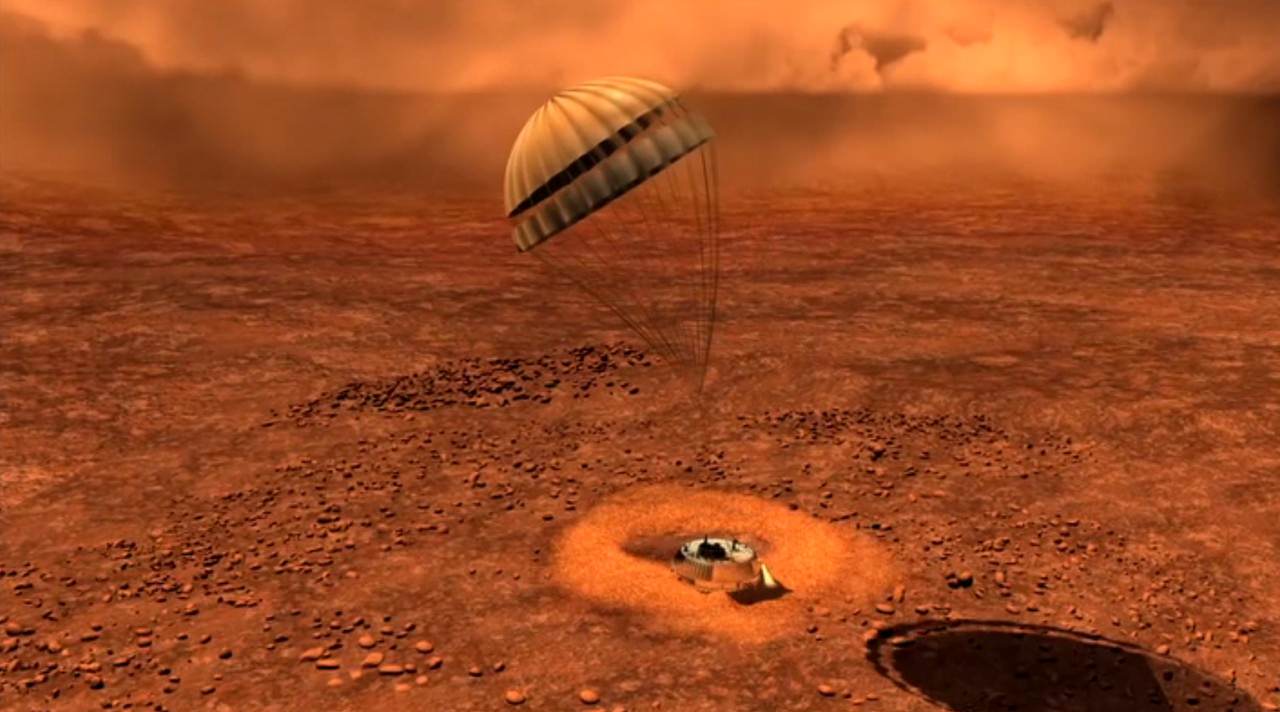It was eight years ago on January 14, 2005 that the Huygens spacecraft descended through Titan’s murky atmosphere and touched down – if a bit precariously – by bouncing, sliding and wobbling across the surface of Saturn’s largest moon Titan. This was the first time a probe had touched down on an alien world in the outer Solar System.
But that surface wasn’t quite what we expected.
While earlier studies of data from Huygens determined the surface of Titan to be quite soft, scientists now think the surface consisted of a hard outer crust but is soft underneath, so that if an object put more pressure on the surface, it sank in significantly.
“It is like snow that has been frozen on top,” said Erich Karkoschka, a co-author of a paper published in October 2012. “If you walk carefully, you can walk as on a solid surface, but if you step on the snow a little too hard, you break in very deeply.”
The scientists think that Huygens landed in something similar to a flood plain on Earth, but that it was dry at the time. The analysis reveals that, on first contact with Titan’s surface, Huygens dug a hole 12 cm deep, before bouncing out onto a flat surface.
The probe, tilted by about 10 degrees in the direction of motion, then slid 30–40 cm across the surface.
A new animation. top of the event has been created using real data recorded by Huygen’s instruments, allowing us to witness this historical moment as if we had been there.
ESA explains:
The animation takes into account Titan’s atmospheric conditions, including the Sun and wind direction, the behaviour of the parachute (with some artistic interpretation only on the movement of the ropes after touchdown), and the dynamics of the landing itself.
Even the stones immediately facing Huygens were rendered to match the photograph of the landing site returned from the probe, which is revealed at the end of the animation.
Split into four sequences, the animation first shows a wide-angle view of the descent and landing followed by two close-ups of the touchdown from different angles, and finally a simulated view from Huygens itself – the true Huygens experience.
Also, a ‘fluffy’ dust-like material – most likely organic aerosols that are known to drizzle out of the Titan atmosphere – was thrown up and suspended for around four seconds around the probe following the impact. The dust was easily lifted, suggesting it was most likely dry and that there had not been any ‘rain’ of liquid ethane or methane for some time prior to the landing.
Huygens was released from the Cassini spacecraft on Christmas Day 2004, and arrived at Titan three weeks later. The probe began transmitting data to Cassini four minutes into its descent and continued to transmit data after landing at least as long as Cassini was above Titan’s horizon, for about 90 minutes, and radio telescopes on Earth continued to receive Huygen’s signal well past the expected lifetime of the craft.
Cassini was supposed to receive Huygen’s signal over two channels, but because of an operational commanding error, only one channel was used. This means that only 350 pictures were received instead of 700 that were expected. All Doppler radio measurements between Cassini and Huygens were lost as well; however, Doppler radio measurements of Huygens from Earth were made, though not as accurate as the expected measurements that Cassini would have made. But when added to accelerometer sensors on Huygens and VLBI tracking of the position of the Huygens probe from Earth, reasonably accurate wind speed and direction measurements could still be derived.
You can see images from the Huygens mission here.
Huygens is currently the most distant landing of any craft launched from Earth. Cassini has been in orbit around Saturn since July 2004, and will continue operations until 2017.


Hi, where i can see the 350 pictures ?
That’s a good question! I’ve added a link to the article but here it is as well.
ESA photos are not in the public domain, like NASA data. ESA tends to horde them.
This was always my favorite visualisation from Huygens: http://www.youtube.com/watch?v=4EWviqSb6mw